Inferential Statistics in Decision Making: A Detailed Analysis Report
VerifiedAdded on 2022/08/14
|7
|1297
|14
Report
AI Summary
This report provides an analysis of a research paper that investigates the impact of leadership styles on employee performance, particularly within the banking sector of Pakistan. The study explores how transformational, transactional, and laissez-faire leadership styles influence employee attitudes and performance. The research highlights the significance of effective leadership in a competitive market environment. The methodology involves a survey of employees from Pakistani banks using a non-random sampling method and a questionnaire based on Bass’s theory of transformational and transactional leadership. The findings indicate a positive correlation between transformational leadership and positive outcomes, while laissez-faire leadership shows a negative correlation. The report concludes with implications for managers seeking to improve leadership approaches and enhance employee performance, emphasizing the importance of understanding the dynamics of leadership in a changing market environment.
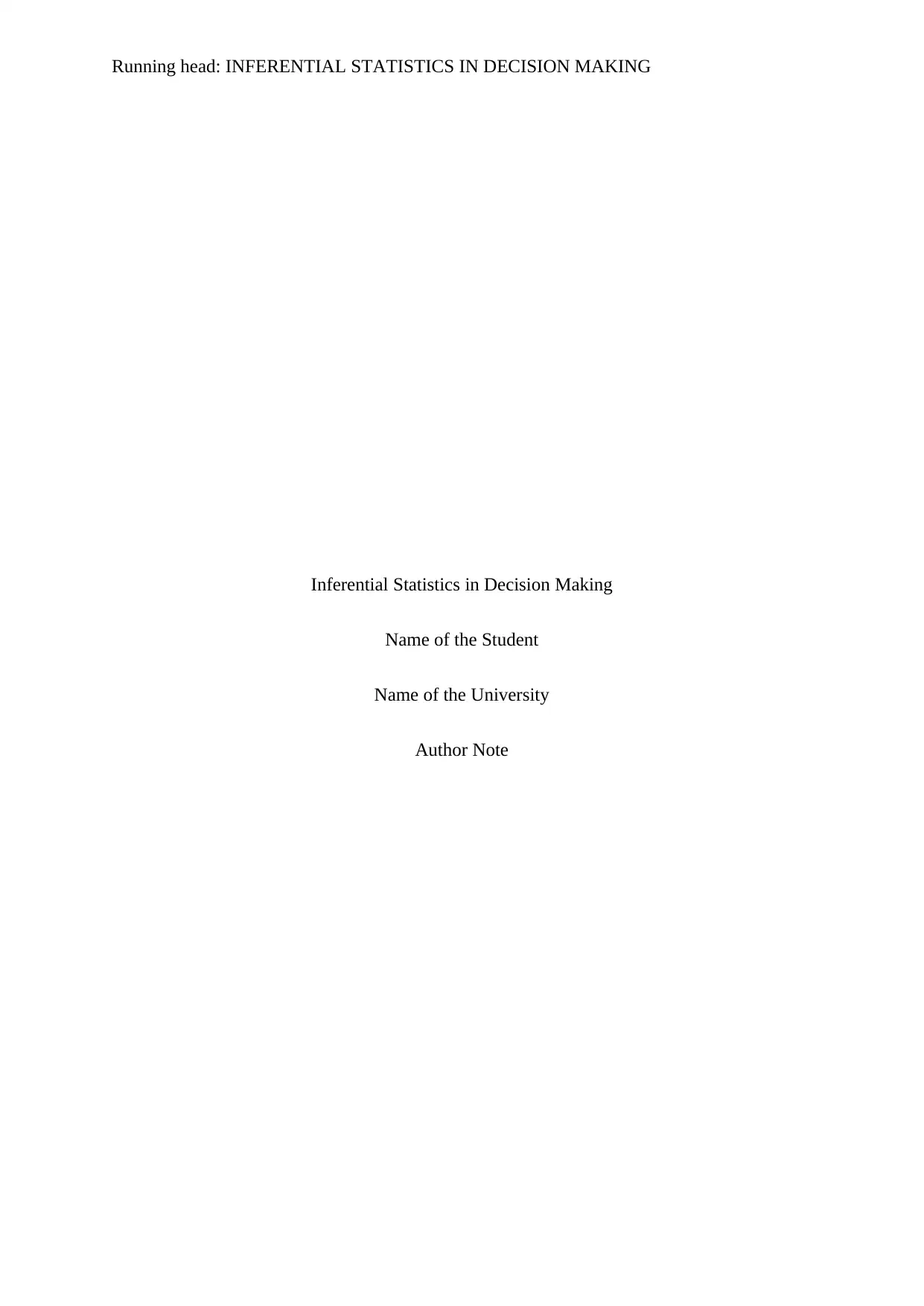
Running head: INFERENTIAL STATISTICS IN DECISION MAKING
Inferential Statistics in Decision Making
Name of the Student
Name of the University
Author Note
Inferential Statistics in Decision Making
Name of the Student
Name of the University
Author Note
Paraphrase This Document
Need a fresh take? Get an instant paraphrase of this document with our AI Paraphraser
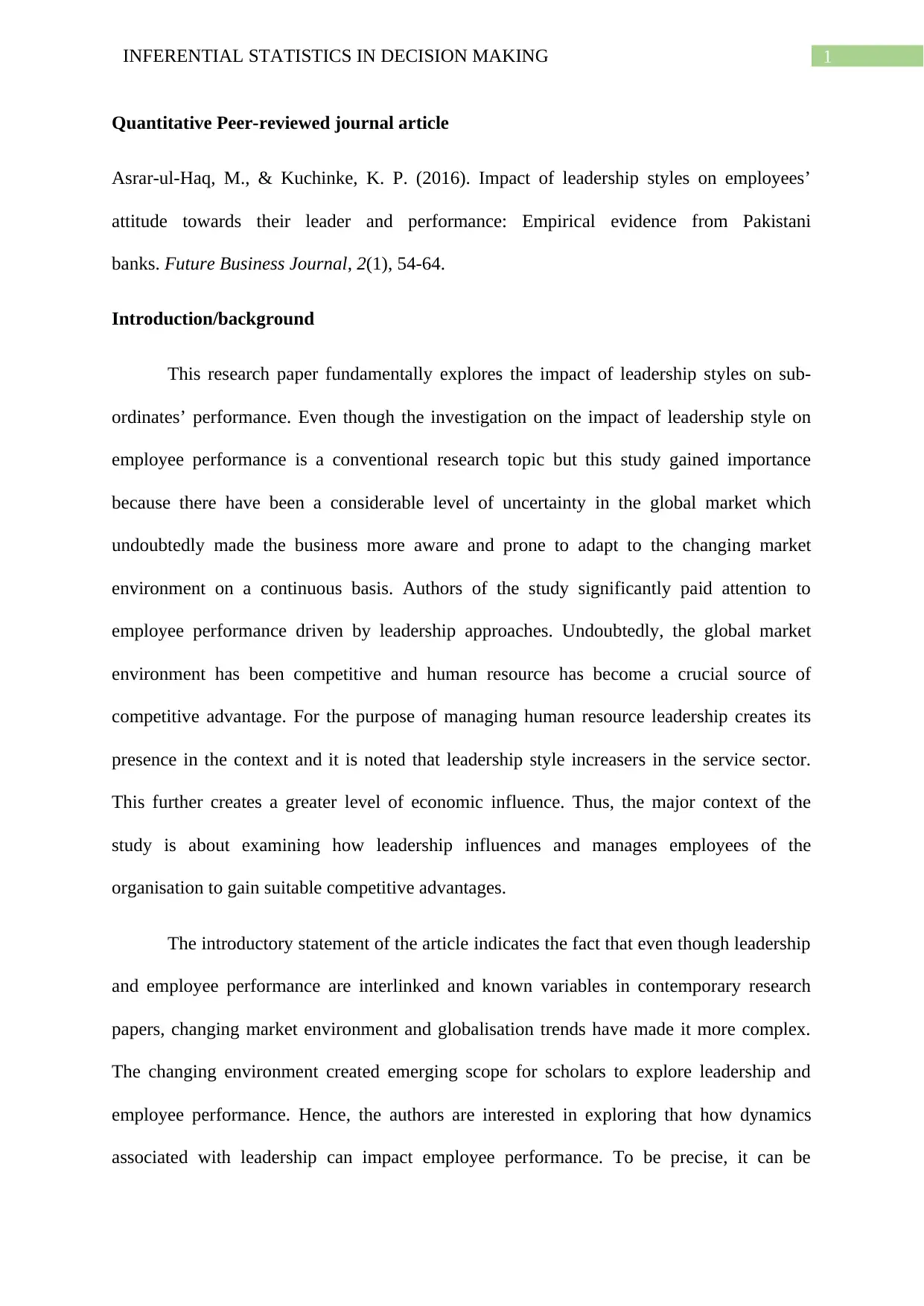
1INFERENTIAL STATISTICS IN DECISION MAKING
Quantitative Peer-reviewed journal article
Asrar-ul-Haq, M., & Kuchinke, K. P. (2016). Impact of leadership styles on employees’
attitude towards their leader and performance: Empirical evidence from Pakistani
banks. Future Business Journal, 2(1), 54-64.
Introduction/background
This research paper fundamentally explores the impact of leadership styles on sub-
ordinates’ performance. Even though the investigation on the impact of leadership style on
employee performance is a conventional research topic but this study gained importance
because there have been a considerable level of uncertainty in the global market which
undoubtedly made the business more aware and prone to adapt to the changing market
environment on a continuous basis. Authors of the study significantly paid attention to
employee performance driven by leadership approaches. Undoubtedly, the global market
environment has been competitive and human resource has become a crucial source of
competitive advantage. For the purpose of managing human resource leadership creates its
presence in the context and it is noted that leadership style increasers in the service sector.
This further creates a greater level of economic influence. Thus, the major context of the
study is about examining how leadership influences and manages employees of the
organisation to gain suitable competitive advantages.
The introductory statement of the article indicates the fact that even though leadership
and employee performance are interlinked and known variables in contemporary research
papers, changing market environment and globalisation trends have made it more complex.
The changing environment created emerging scope for scholars to explore leadership and
employee performance. Hence, the authors are interested in exploring that how dynamics
associated with leadership can impact employee performance. To be precise, it can be
Quantitative Peer-reviewed journal article
Asrar-ul-Haq, M., & Kuchinke, K. P. (2016). Impact of leadership styles on employees’
attitude towards their leader and performance: Empirical evidence from Pakistani
banks. Future Business Journal, 2(1), 54-64.
Introduction/background
This research paper fundamentally explores the impact of leadership styles on sub-
ordinates’ performance. Even though the investigation on the impact of leadership style on
employee performance is a conventional research topic but this study gained importance
because there have been a considerable level of uncertainty in the global market which
undoubtedly made the business more aware and prone to adapt to the changing market
environment on a continuous basis. Authors of the study significantly paid attention to
employee performance driven by leadership approaches. Undoubtedly, the global market
environment has been competitive and human resource has become a crucial source of
competitive advantage. For the purpose of managing human resource leadership creates its
presence in the context and it is noted that leadership style increasers in the service sector.
This further creates a greater level of economic influence. Thus, the major context of the
study is about examining how leadership influences and manages employees of the
organisation to gain suitable competitive advantages.
The introductory statement of the article indicates the fact that even though leadership
and employee performance are interlinked and known variables in contemporary research
papers, changing market environment and globalisation trends have made it more complex.
The changing environment created emerging scope for scholars to explore leadership and
employee performance. Hence, the authors are interested in exploring that how dynamics
associated with leadership can impact employee performance. To be precise, it can be
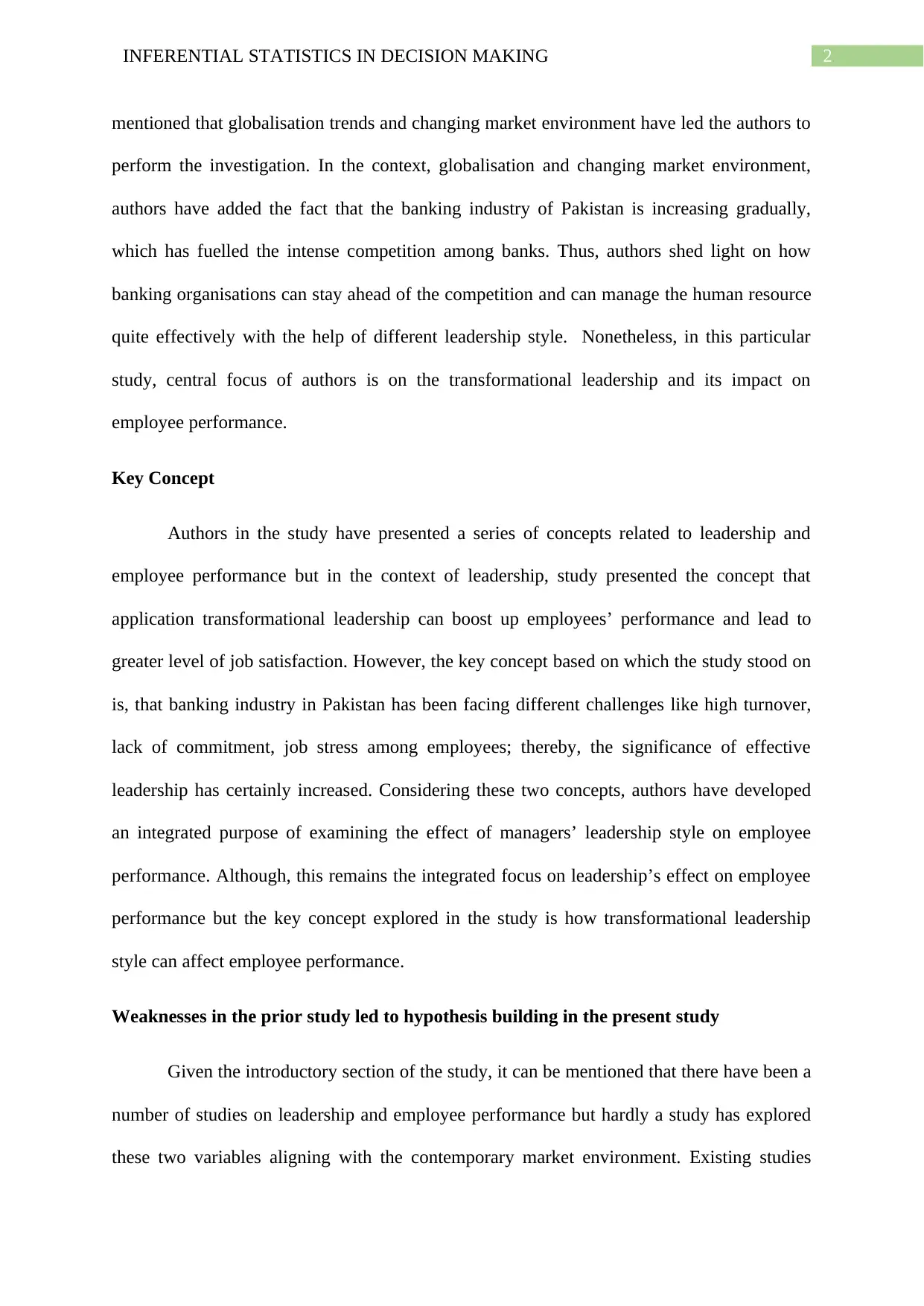
2INFERENTIAL STATISTICS IN DECISION MAKING
mentioned that globalisation trends and changing market environment have led the authors to
perform the investigation. In the context, globalisation and changing market environment,
authors have added the fact that the banking industry of Pakistan is increasing gradually,
which has fuelled the intense competition among banks. Thus, authors shed light on how
banking organisations can stay ahead of the competition and can manage the human resource
quite effectively with the help of different leadership style. Nonetheless, in this particular
study, central focus of authors is on the transformational leadership and its impact on
employee performance.
Key Concept
Authors in the study have presented a series of concepts related to leadership and
employee performance but in the context of leadership, study presented the concept that
application transformational leadership can boost up employees’ performance and lead to
greater level of job satisfaction. However, the key concept based on which the study stood on
is, that banking industry in Pakistan has been facing different challenges like high turnover,
lack of commitment, job stress among employees; thereby, the significance of effective
leadership has certainly increased. Considering these two concepts, authors have developed
an integrated purpose of examining the effect of managers’ leadership style on employee
performance. Although, this remains the integrated focus on leadership’s effect on employee
performance but the key concept explored in the study is how transformational leadership
style can affect employee performance.
Weaknesses in the prior study led to hypothesis building in the present study
Given the introductory section of the study, it can be mentioned that there have been a
number of studies on leadership and employee performance but hardly a study has explored
these two variables aligning with the contemporary market environment. Existing studies
mentioned that globalisation trends and changing market environment have led the authors to
perform the investigation. In the context, globalisation and changing market environment,
authors have added the fact that the banking industry of Pakistan is increasing gradually,
which has fuelled the intense competition among banks. Thus, authors shed light on how
banking organisations can stay ahead of the competition and can manage the human resource
quite effectively with the help of different leadership style. Nonetheless, in this particular
study, central focus of authors is on the transformational leadership and its impact on
employee performance.
Key Concept
Authors in the study have presented a series of concepts related to leadership and
employee performance but in the context of leadership, study presented the concept that
application transformational leadership can boost up employees’ performance and lead to
greater level of job satisfaction. However, the key concept based on which the study stood on
is, that banking industry in Pakistan has been facing different challenges like high turnover,
lack of commitment, job stress among employees; thereby, the significance of effective
leadership has certainly increased. Considering these two concepts, authors have developed
an integrated purpose of examining the effect of managers’ leadership style on employee
performance. Although, this remains the integrated focus on leadership’s effect on employee
performance but the key concept explored in the study is how transformational leadership
style can affect employee performance.
Weaknesses in the prior study led to hypothesis building in the present study
Given the introductory section of the study, it can be mentioned that there have been a
number of studies on leadership and employee performance but hardly a study has explored
these two variables aligning with the contemporary market environment. Existing studies
⊘ This is a preview!⊘
Do you want full access?
Subscribe today to unlock all pages.

Trusted by 1+ million students worldwide
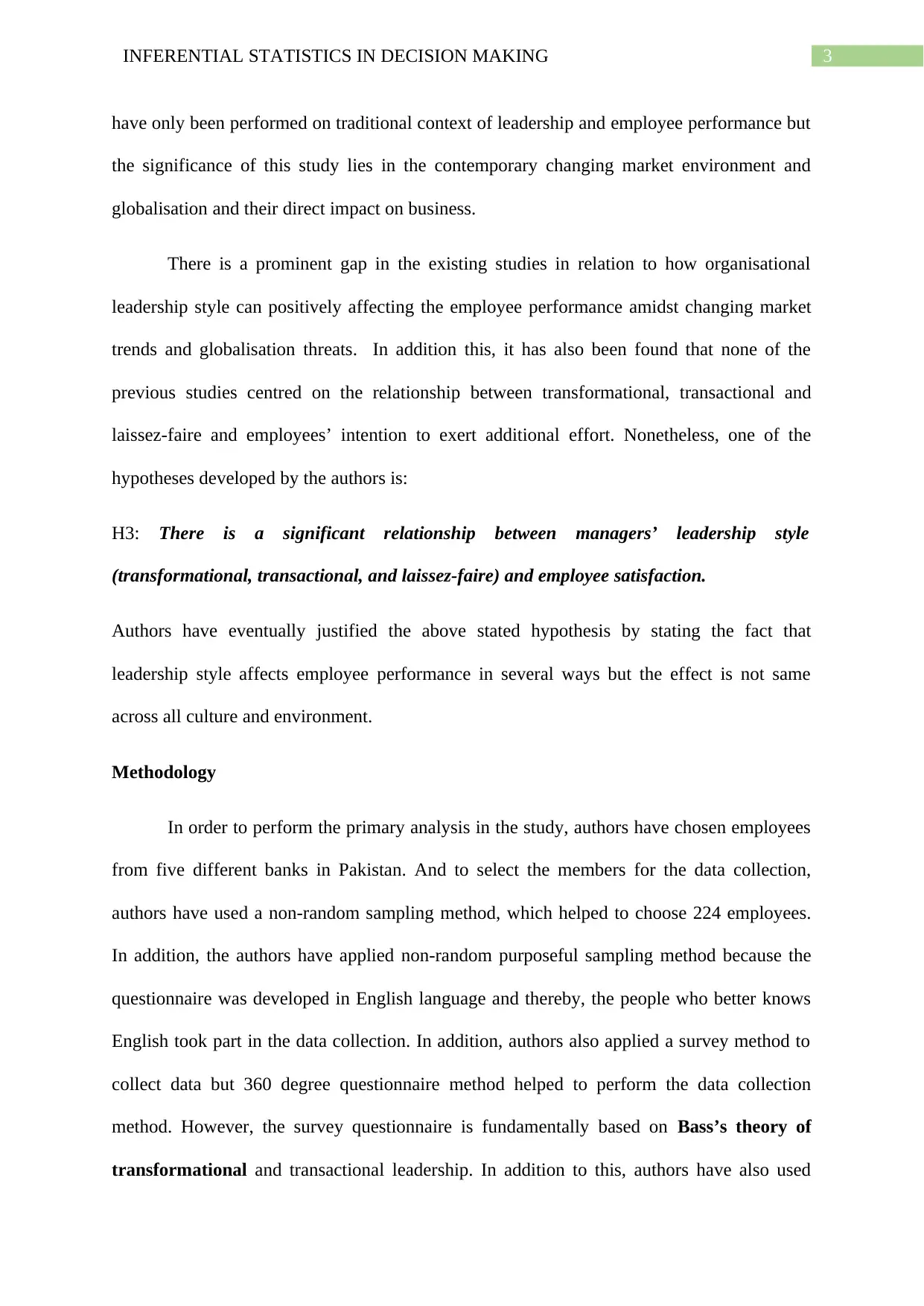
3INFERENTIAL STATISTICS IN DECISION MAKING
have only been performed on traditional context of leadership and employee performance but
the significance of this study lies in the contemporary changing market environment and
globalisation and their direct impact on business.
There is a prominent gap in the existing studies in relation to how organisational
leadership style can positively affecting the employee performance amidst changing market
trends and globalisation threats. In addition this, it has also been found that none of the
previous studies centred on the relationship between transformational, transactional and
laissez-faire and employees’ intention to exert additional effort. Nonetheless, one of the
hypotheses developed by the authors is:
H3: There is a significant relationship between managers’ leadership style
(transformational, transactional, and laissez-faire) and employee satisfaction.
Authors have eventually justified the above stated hypothesis by stating the fact that
leadership style affects employee performance in several ways but the effect is not same
across all culture and environment.
Methodology
In order to perform the primary analysis in the study, authors have chosen employees
from five different banks in Pakistan. And to select the members for the data collection,
authors have used a non-random sampling method, which helped to choose 224 employees.
In addition, the authors have applied non-random purposeful sampling method because the
questionnaire was developed in English language and thereby, the people who better knows
English took part in the data collection. In addition, authors also applied a survey method to
collect data but 360 degree questionnaire method helped to perform the data collection
method. However, the survey questionnaire is fundamentally based on Bass’s theory of
transformational and transactional leadership. In addition to this, authors have also used
have only been performed on traditional context of leadership and employee performance but
the significance of this study lies in the contemporary changing market environment and
globalisation and their direct impact on business.
There is a prominent gap in the existing studies in relation to how organisational
leadership style can positively affecting the employee performance amidst changing market
trends and globalisation threats. In addition this, it has also been found that none of the
previous studies centred on the relationship between transformational, transactional and
laissez-faire and employees’ intention to exert additional effort. Nonetheless, one of the
hypotheses developed by the authors is:
H3: There is a significant relationship between managers’ leadership style
(transformational, transactional, and laissez-faire) and employee satisfaction.
Authors have eventually justified the above stated hypothesis by stating the fact that
leadership style affects employee performance in several ways but the effect is not same
across all culture and environment.
Methodology
In order to perform the primary analysis in the study, authors have chosen employees
from five different banks in Pakistan. And to select the members for the data collection,
authors have used a non-random sampling method, which helped to choose 224 employees.
In addition, the authors have applied non-random purposeful sampling method because the
questionnaire was developed in English language and thereby, the people who better knows
English took part in the data collection. In addition, authors also applied a survey method to
collect data but 360 degree questionnaire method helped to perform the data collection
method. However, the survey questionnaire is fundamentally based on Bass’s theory of
transformational and transactional leadership. In addition to this, authors have also used
Paraphrase This Document
Need a fresh take? Get an instant paraphrase of this document with our AI Paraphraser
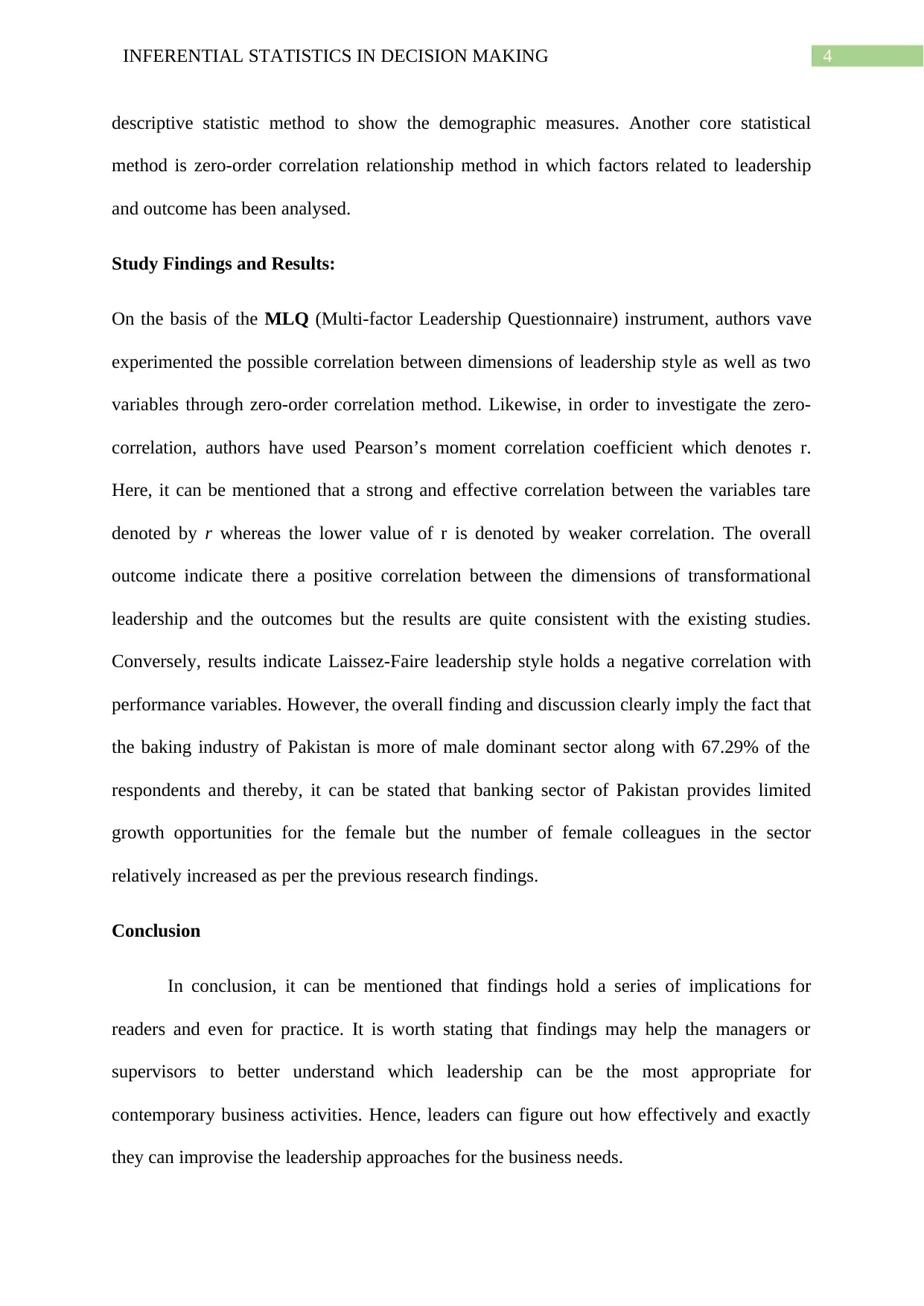
4INFERENTIAL STATISTICS IN DECISION MAKING
descriptive statistic method to show the demographic measures. Another core statistical
method is zero-order correlation relationship method in which factors related to leadership
and outcome has been analysed.
Study Findings and Results:
On the basis of the MLQ (Multi-factor Leadership Questionnaire) instrument, authors vave
experimented the possible correlation between dimensions of leadership style as well as two
variables through zero-order correlation method. Likewise, in order to investigate the zero-
correlation, authors have used Pearson’s moment correlation coefficient which denotes r.
Here, it can be mentioned that a strong and effective correlation between the variables tare
denoted by r whereas the lower value of r is denoted by weaker correlation. The overall
outcome indicate there a positive correlation between the dimensions of transformational
leadership and the outcomes but the results are quite consistent with the existing studies.
Conversely, results indicate Laissez-Faire leadership style holds a negative correlation with
performance variables. However, the overall finding and discussion clearly imply the fact that
the baking industry of Pakistan is more of male dominant sector along with 67.29% of the
respondents and thereby, it can be stated that banking sector of Pakistan provides limited
growth opportunities for the female but the number of female colleagues in the sector
relatively increased as per the previous research findings.
Conclusion
In conclusion, it can be mentioned that findings hold a series of implications for
readers and even for practice. It is worth stating that findings may help the managers or
supervisors to better understand which leadership can be the most appropriate for
contemporary business activities. Hence, leaders can figure out how effectively and exactly
they can improvise the leadership approaches for the business needs.
descriptive statistic method to show the demographic measures. Another core statistical
method is zero-order correlation relationship method in which factors related to leadership
and outcome has been analysed.
Study Findings and Results:
On the basis of the MLQ (Multi-factor Leadership Questionnaire) instrument, authors vave
experimented the possible correlation between dimensions of leadership style as well as two
variables through zero-order correlation method. Likewise, in order to investigate the zero-
correlation, authors have used Pearson’s moment correlation coefficient which denotes r.
Here, it can be mentioned that a strong and effective correlation between the variables tare
denoted by r whereas the lower value of r is denoted by weaker correlation. The overall
outcome indicate there a positive correlation between the dimensions of transformational
leadership and the outcomes but the results are quite consistent with the existing studies.
Conversely, results indicate Laissez-Faire leadership style holds a negative correlation with
performance variables. However, the overall finding and discussion clearly imply the fact that
the baking industry of Pakistan is more of male dominant sector along with 67.29% of the
respondents and thereby, it can be stated that banking sector of Pakistan provides limited
growth opportunities for the female but the number of female colleagues in the sector
relatively increased as per the previous research findings.
Conclusion
In conclusion, it can be mentioned that findings hold a series of implications for
readers and even for practice. It is worth stating that findings may help the managers or
supervisors to better understand which leadership can be the most appropriate for
contemporary business activities. Hence, leaders can figure out how effectively and exactly
they can improvise the leadership approaches for the business needs.

5INFERENTIAL STATISTICS IN DECISION MAKING
⊘ This is a preview!⊘
Do you want full access?
Subscribe today to unlock all pages.

Trusted by 1+ million students worldwide
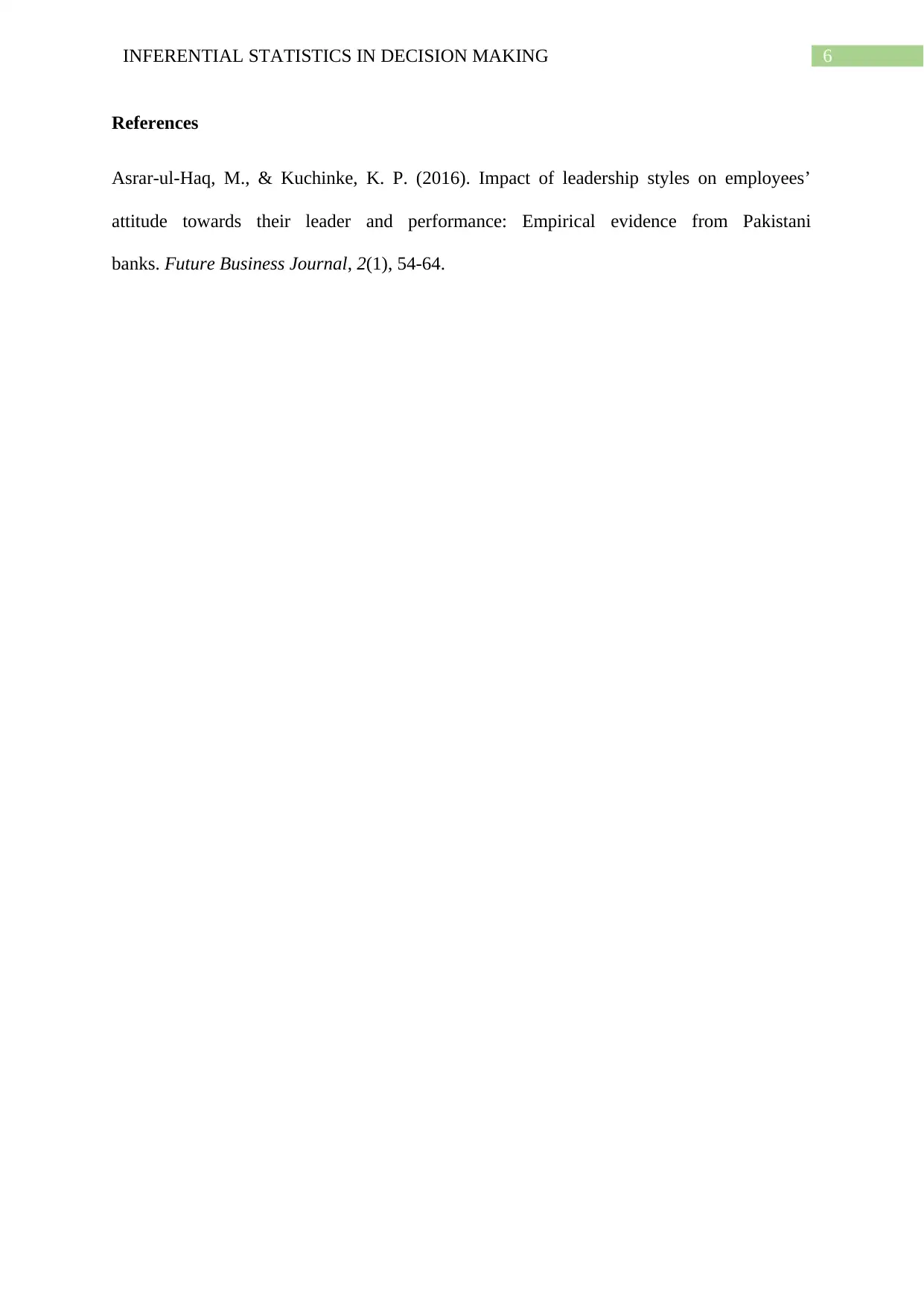
6INFERENTIAL STATISTICS IN DECISION MAKING
References
Asrar-ul-Haq, M., & Kuchinke, K. P. (2016). Impact of leadership styles on employees’
attitude towards their leader and performance: Empirical evidence from Pakistani
banks. Future Business Journal, 2(1), 54-64.
References
Asrar-ul-Haq, M., & Kuchinke, K. P. (2016). Impact of leadership styles on employees’
attitude towards their leader and performance: Empirical evidence from Pakistani
banks. Future Business Journal, 2(1), 54-64.
1 out of 7
Related Documents
Your All-in-One AI-Powered Toolkit for Academic Success.
+13062052269
info@desklib.com
Available 24*7 on WhatsApp / Email
![[object Object]](/_next/static/media/star-bottom.7253800d.svg)
Unlock your academic potential
Copyright © 2020–2025 A2Z Services. All Rights Reserved. Developed and managed by ZUCOL.





